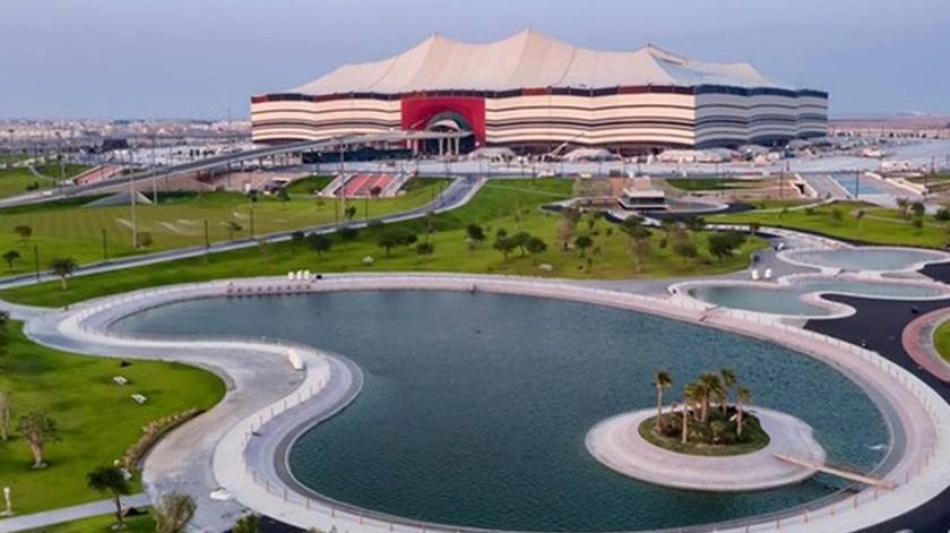Doha: Al Bayt Stadium is one of the FIFA World Cup Qatar 2022 most distinctive stadiums with a distinctive and unique design that embodies an important part of the past of the State of Qatar and imitates its present; and it is the stadium that will host the opening match between Qatar and Ecuador.
Al Bayt Stadium is a role model in future stadium construction as a world-class edifice that achieves the goals of legacy, sustainability and environmental-friendly development while considering future societal requirements.
The design of Al Bayt Stadium was inspired by the Bayt Al Shaar, taking the form of the traditional tent of the nomadic people who have lived in the deserts of Qatar thousands of years ago.
Al Bayt Stadium has a distinguished location adjacent to Al Khor Coastal Road in Al Khor city in northern Qatar, 35km north of the heart of Doha.
The stadium has a capacity of 60,000 audiences, and will host 9 World Cup matches, including 6 matches in the group stage starting with opening match between Qatar and Ecuador on November 20, 1 round of 16 games, 1 quarterfinal game and 1 semifinal game.
Al Bayt Stadium was officially inaugurated with a huge artistic and football festival on November 30, 2021, with the opening match of the 2021 FIFA Arab Cup between Qatar and Bahrain.
HH the Emir Sheikh Tamim bin Hamad Al Thani announced the official opening of the tournament in the presence of FIFA President Gianni Infantino and several Arab heads of state and senior officials.
The tournament, which was regarded as a rehearsal for the World Cup, achieved great success in all aspects and the Algerian national team won its title.
Al Bayt Stadium has four main outdoor playgrounds to be used for training during the tournament, in addition to six restaurants around the areas dedicated for families and children’s playing area.
The facility includes more than 190 electronic gates distributed around it for public access and exit, as well as 12 emergency tunnels to be used in the event of an emergency.
There is also a main tunnel for the entry and exit of logistics mechanisms and the delivery of food to restaurants inside the stadium.
Fans can easily reach Al Bayt Stadium within half an hour, whether by private cars or public transport from Doha to the stadium directly via the newly established Al Khor Coastal Road which was newly built according to highest international standards. Al Khor Coastal Road can be reached from all cities around Qatar via Al Majed Road and Al Shamal Road.
Lusail Station is the closest Doha Metro station to Al Bayt Stadium. It is located directly on the Al Khor Coastal Road, about 20km from the stadium, which enables the public to travel by metro and then take public transport buses that pass directly next to the station, and it takes about 20 minutes.
Al Bayt Stadium was built by Aspire Zone Foundation (AZF). Its design was inspired by Bayt Al Shaar inhabited by the nomadic people who have lived in the deserts of Qatar. Its structure embodies the form of a huge traditional tent covering the entire stadium, in the form of the Bayt Al Shaar, from which its name was inspired.
The Bayt Al Shaar is identified by black and white stripes which is reflected in the distinctive outer facade of the stadium, giving fans a welcome feeling upon entering the Stadium with Al Sadus vibrant inscriptions that reflect the heritage and were used to decorate the tents inhabited by the people in Qatar and the Gulf region throughout history.
Sustainability was given the utmost importance during the design and construction of Al Bayt Stadium. The seats in the upper part of the stands were designed to be dismantled after the end of the World Cup to donate them to other countries.
The main idea of Al Bayt Stadium, which came in co-operation with the Aspire Zone Foundation (AZF), is based on sustainability and low energy consumption.
The design of the stadium will reduce the amount of energy required to maintain comfortable and cool atmosphere inside the stadium, thanks to the lightweight canopies inspired by the tent structure which will cast a shadow over the pitch from all sides, complementing the work of the air-cooling technologies available in the place.
The cooling technology used in Al Bayt Stadium and the rest of the Qatar World Cup stadiums is a development of the second-generation technology used in Khalifa International Stadium, the first World Cup stadium that opened in May, 2017.
The technology will be more sustainable, especially in terms of the use of clean and environmental-friendly energy. The cooling technology in the stadium is divided into several levels, the first is the cooling of the stadium for players and referees, followed by the cooling of the lower, middle, and upper stands gradually.
All eight stadiums for the FIFA World Cup Qatar 2022 have obtained the Global Sustainability Assessment System (GSAS) certificate, three of them received the four-star rating, while the others were awarded the five-star rating.
The GSAS has been approved by the FIFA and ensures that the tournament’s infrastructure meets a set of strict environmental standards.
Source: QNA


